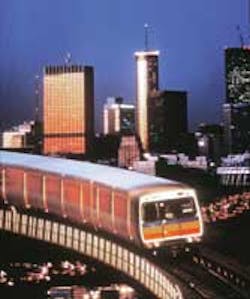Transit authorities are public agencies formed by cities, counties and states to acquire and then operate and maintain transportation (buses, rails, street cars, etc.). State, county and city laws establish transit authorities for the convenience and safety of the public.
The state and local governments normally oversee the transit authority board of directors who control the operation of the transportation. Transit authority employees can either work for the company directly or one or more unions. Locksmiths that work for transit authorities can be part of a union that is contracted with the authority. Union locksmiths adhere to precise job specifications. The locksmith cannot perform duties not described in the job specifications. Other trades can perform some of the duties assigned to the locksmith if the duties are also declared in their job specifications.
At a typical transit authority, locksmiths work under moderate supervision. They install, maintain and repair lock systems and related equipment. Locksmiths perform journey-level installation, maintenance and repair of lock-related equipment, while property maintenance or similar job may perform basic lock installations.
Because the wording is very important in the job specifications, here is a word-for-word description of the example of locksmith duties at a typical transit authority:
- Installs all types of locks and lock hardware and perform the carpentry necessary for such installation.
- Adjusts, maintains, repairs and replaces conventional door locks, padlocks, tumbler locks, and various other lock hardware such as panic bars, door checks, latches, catches, fasteners, and door closers.
- Establishes and maintains master key systems.
- Open locks which cannot be opened by ordinary means.
- Operates machine tools such as key-cutting machine, drill press, grinder, hand drill, electric drill, and electrical hammer to duplicate keys and change locks.
- Selects key blanks, cut keys, and fits keys to locks.
- Issue keys and locks and keeps related records.
- Maintain a supply of locks, lock parts, and key parts.
- Responsible for maintaining, supporting, and promoting a safe work environment while complying with all company safety rules; policies; and procedures.
Although the above description seems cumbersome, it is designed to differentiate the tasks of locksmiths from other trades-persons like carpenters, electricians, system techs and property maintenance. For instance, the property maintenance can swap out locksets or exit devices since these tasks do not require journey-level skills.
Performing the necessary "carpentry" for installations precludes the TA (transit authority) locksmith from working on metal doors as carpentry limits installations to wood doors.
This part of the description was intended to address the installation of auxiliary locks like deadbolts, hasps, and slide bolts. Most of the metal doors within the authority are fire doors. Auxiliary locks would never be installed on fire doors.
The description limits the locksmith to, "…Adjusts, maintains, repairs and replaces conventional door locks, padlocks, tumbler locks, and various other lock hardware such as panic bars, door checks, latches, catches, fasteners, and door closers…"
Here the intention is to keep the locksmith from working with electric/electronic hardware such as magnetic locks, electric strikes, card readers, controllers, and power supplies. It also keeps the locksmith from working on safes and vaults.
The description also infers that locksmiths are not intended to be "door openers." The statement that locksmiths "open locks which cannot be opened by ordinary means" keeps the locksmith from running around opening doors with keys (the ordinary means). Without this statement, all of the locksmith's time would be occupied by requests to open office doors when someone forgot a key.
The mention of what machine tools a locksmith can operate develops a focus on cutting keys and change locks.
Transit authority locksmiths primarily establish and maintain master key systems while issuing keys and keeping related records.
Most requestors want their requests handled immediately. Realistically, because of the number of requests each day, everything must be prioritized.
Requests for services are discriminated as either emergency or routine services.
Emergency services are those that are immediately performed as they either present a safety problem or security failure.
Typical safety problems would be doors that lock persons into rooms or exit devices that do not release when the paddle or bar is pushed. Security issues relate to doors that will not latch or locks that have failed.
Routine calls are those where areas have to be rekeyed or a lock has failed but there are no safety or security issues.
Routine requests are further prioritized into three categories: requests that need to be performed soon; requests that need to be performed within a few weeks; and casual requests where there is no urgency.
Requests needing to be performed soon are those requests where business is inhibited until the request is performed. A typical example would be the rekey of a new storage room where nothing can be stored until the room is rekeyed.
Requests that need to be performed in a few weeks are those requests where business is not inhibited but it is reasonable to perform the service. A typical example of this would be the rekey of a room that is keyed different than other rooms that are keyed alike.
Casual requests where there is no urgency might be a request to rekey several desks alike. Many of these requests make persons happy but are do not necessarily improve the flow of business.
Most lock services performed throughout the authority are: lock repairs; lock cylinder and core servicing or rekeying; and opening locks without keys.
Many locks throughout the authority are frequently used and can therefore prematurely breakdown or need repair. For instance, restrooms used by bus drivers will be accessed hundreds of times a day. It is not uncommon for lock cylinders to wear out in months versus years. A transit authority may have hundreds of these types of doors so the chances are that one or more service calls (per day) will be to drill out a restroom lock cylinder.
Another daily request (or two) will have the locksmith replacing broken spindles and missing levers relating to mortise locksets.
Exit devices, closers and locks located within subways can prematurely breakdown due to constant pressure changes.
Trains that run through tunnels act like gigantic pistons so when rails are coming into platforms, doors are pushed closed with tremendous force. As trains leave the tunnel doors are thrown open with equal force.
Exit device fasteners can quickly vibrate loose under these conditions. The bolts that secure the exit trim are very vulnerable. Left in a loose condition, they can shear off.
With large transit authorities, there is at least one exit device repair per day. Vertical-rod exit devices seem to be more prone to failure.
Any transit authority will have thousands of padlocks. Each day there will be padlock issues regarding repairs, replacements, or rekeying.
Today's transit authorities gravitate to interchangeable core whenever possible.
There is always a lot of rekeying taking place in the lock shop and the only reasonable means to accomplish all of it is to use interchangeable cores.
There is a lot of office movement within transit authorities that add to the number of lock cylinders and cores rekeyed each day.
Adding to daily lock requests are all the cabinets, boxes, cases, and panels that are secured by utility, cam, and cabinet locks. In between the priority requests, these locks are being rekeyed or replaced.
Transit authority locksmiths are always busy and it becomes evident as to why they do not open vehicles, act as roving guards (opening offices), open safes, or service electric locks.
There is an equal amount of key service in the lock shop.
By the nature of union personnel, employees can re-bid job assignments each year. This creates situations where whole rings of keys have to be made.
Key rings are issued by the type of job a person is assigned to. Whether it is a custodian, rail inspector, or train operator, there is a specific ring and usually with a lot of controlled and uncontrolled keys.
Controlled keys are those that are specifically assigned to individuals and by nature they can be controlled. These are door keys or other high-priority keys where the key blank stock is restricted or patented, therefore controllable.
Uncontrolled keys are those where it is impossible to eliminate unauthorized duplication. As an example common cabinets may be locked with a simple cam lock. The face of the cam lock is stamped 1250.
The key blanks are not restricted regarding this key and anyone can get this key made by local key shops just be referencing the number.
In transit authorities there are hundreds of different types of uncontrolled keys.
There will be at least a couple of hundred uncontrolled keys cut at the shop each day.
In addition to key fabrication and duplication, there are significant numbers of record changes that need to be performed daily:
People transfer or terminate and each event generates record changes.
Keys are swapped and the transaction needs to be recorded.
Each controlled key issued requires a new record be appended to the database.
To complete the task, meaningful reports need to be distributed regarding key control additions or changes.
To accomplish services in a timely manner, locks, parts, and key blanks need to be stocked.
An ordering system usually is integrated into the departmental software so that the tracking of service calls and key issuance will generate a needed list of materials.
Transit authorities usually have universal store areas where common items can be automatically stocked and drawn from by the locksmith.
A typical item might be interchangeable cores. Instead of the locksmith stocking hundreds of cores in the lock shop, the universal store can maintain a specified number of cores. When a designated minimum quantity of cores is reached, the cores are automatically ordered for the locksmith.
Other common items stocked by the universal store might be locksets, panic bars, key blanks, padlocks, etc.
Transit authorities whenever possible log all activities into the companies' databases.
Much of the locksmith's activities are captured in the companies' database.
Receiving, dispatching, and reconciling service requests are usually tied into such databases.
Other activities like pinning lock cylinders and cores or recording the status of keys is best left to specialized software designed for the locksmith industry.
The Transit authority locksmith spends a great deal of time working with both the companies' databases and specialized software. In addition to working with software, the locksmith will use email and the Internet throughout the day.
Email is used to clarify service requests, notify employees when keys are ready for pickup, and sending reports to management.
Almost all manufacturers offer web equivalents of: catalogs, cut sheets, exploded views, and product alerts relating to door and locking hardware.
The distributors that cater to institutional locksmiths make available web tools that streamline the ordering process.
There is plenty of opportunity for the locksmith to design and then fabricate custom locks and devices that meet the special needs of the transit authority.
For example, a transit authority had the need to secure portable toilets so that drivers could use have exclusive use of the facilities when traveling along bus routes. The locksmith for the transit authority came up with an elegant solution. A surface-mounted case was designed to accommodate an Adams-Rite mortise latch. A hole was drilled through the plastic door for the mortise cylinder then the case was mounted using through-bolts.
Once installed the toilet door becomes self-latching and can be secured with a standard mortise cylinder.
Another example found a transit authority looking for different means to secure padlocks to chain-link fences.
Those padlock retainers and chains offered by the manufacturer were not durable enough to handle the abuse dished out in an urban environment.
Heavier chain was needed but there wasn't a good means to retain it to the padlock.
A simple and effective fix was to remove the hasp of the padlock and slip on a 3/8" rod connector. This retained the heavier chain and allowed the locksmith to stamp identification numbers on it.





